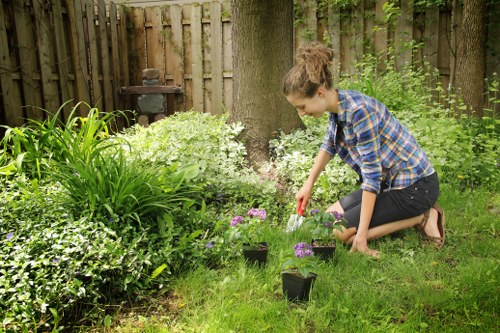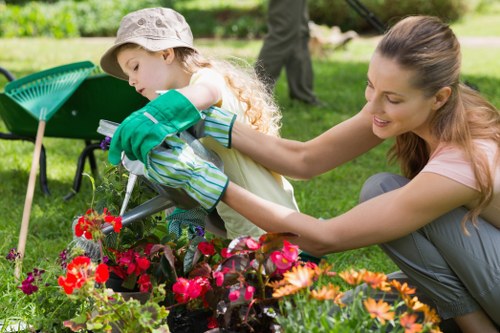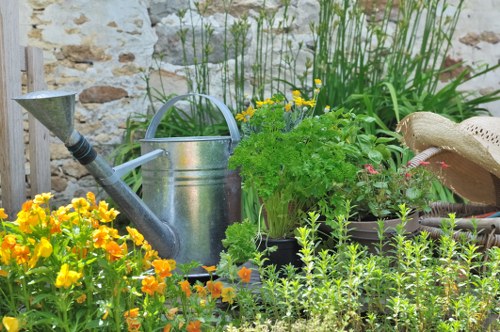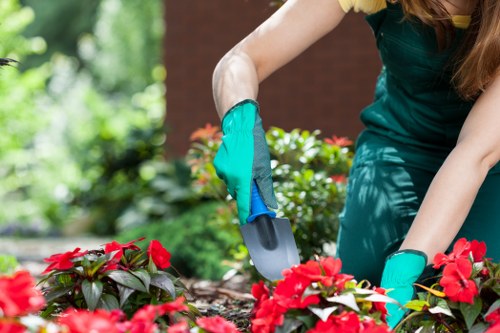Landscaping in St Johns Wood: Transforming Gardens into Urban Oases

St Johns Wood, an affluent area in northwest London, is renowned for its elegant homes, lush gardens, and picturesque streets. Landscaping in St Johns Wood is more than just a hobby; it's a passion that enhances the beauty and value of properties while providing residents with serene outdoor retreats. Whether you're looking to revamp your existing garden or embark on a new landscaping project, understanding the unique characteristics and opportunities of St Johns Wood is essential.
The area's rich history and blend of Victorian and Edwardian architecture provide a perfect backdrop for creative landscaping. From traditional English gardens to modern minimalist designs, the possibilities are endless. In this article, we'll explore the key aspects of landscaping in St Johns Wood, offering insights into design trends, plant selection, and practical tips to create a stunning outdoor space.
One of the first steps in any landscaping project is to assess the existing conditions of your garden. Factors such as soil type, sunlight exposure, and drainage play a crucial role in determining which plants will thrive. St Johns Wood's climate, characterized by mild winters and warm summers, supports a diverse range of flora, allowing homeowners to experiment with various styles and plant combinations.
The Importance of Professional Landscaping Services

While DIY landscaping can be fulfilling, hiring professional landscaping services in St Johns Wood offers numerous advantages. Professional landscapers bring expertise in design, plant selection, and maintenance, ensuring that your garden not only looks beautiful but also remains healthy and sustainable.
Professional landscapers understand the local climate and soil conditions, allowing them to choose plants that are well-suited to thrive in St Johns Wood. They can also provide customized solutions that align with your personal preferences and the architectural style of your home. From creating stunning flower beds to installing sophisticated irrigation systems, professional services ensure a seamless and hassle-free transformation of your outdoor space.
Moreover, professionals can help you navigate any local regulations or restrictions related to landscaping. In St Johns Wood, where many properties are listed or located within conservation areas, it's essential to comply with specific guidelines to maintain the area's historic charm. A professional landscaper will ensure that your project adheres to these regulations, avoiding potential issues down the line.
Top Landscaping Trends in St Johns Wood

St Johns Wood's landscaping trends reflect a harmonious blend of traditional elegance and contemporary innovation. Here are some of the top trends that are currently shaping gardens in the area:
- English Cottage Gardens: Embracing a romantic and whimsical aesthetic, English cottage gardens feature a mix of colorful flowers, climbing plants, and rustic elements. This style is perfect for creating a charming and inviting outdoor space.
- Modern Minimalism: For those who prefer a sleek and uncluttered look, modern minimalist gardens focus on clean lines, geometric shapes, and a restrained color palette. This approach emphasizes simplicity and functionality.
- Sustainable Landscaping: With increasing awareness of environmental conservation, sustainable landscaping practices are gaining popularity. This includes the use of native plants, water-efficient irrigation systems, and eco-friendly materials.
- Outdoor Living Spaces: Expanding the usability of gardens by incorporating outdoor kitchens, seating areas, and fire pits is a growing trend. These spaces provide a perfect setting for entertaining and relaxation.
- Vertical Gardens: Maximizing space through vertical gardens is especially beneficial in urban settings like St Johns Wood. Vertical gardens add greenery without occupying valuable ground space, making them ideal for smaller gardens.
Choosing the Right Plants for Your Garden

Plant selection is a cornerstone of successful landscaping. In St Johns Wood, the diverse climate allows for a wide variety of plants to flourish. When selecting plants, consider factors such as bloom time, growth habits, and maintenance requirements.
Perennials: These plants come back year after year, providing long-term color and structure to your garden. Popular perennials in St Johns Wood include lavender, peonies, and hostas.
Evergreens: To maintain greenery throughout the year, incorporate evergreen shrubs and trees such as boxwood, holly, and cedar. These plants add texture and depth to the landscape.
Seasonal Flowers: For vibrant, seasonal displays, choose flowers like tulips in spring, dahlias in summer, chrysanthemums in autumn, and poinsettias in winter.
Pro Tip: Mix plants with different bloom times to ensure your garden remains colorful throughout the year.
Hardscaping Elements to Enhance Your Garden

Hardscaping involves the use of non-living elements to create structure and functionality in your garden. Incorporating hardscaping elements can significantly enhance the aesthetic appeal and usability of your outdoor space.
Patios and Decks: Creating defined outdoor living areas with patios or decks provides a perfect setting for dining, relaxation, and social gatherings. Materials such as natural stone, brick, and composite decking are popular choices.
Paths and Walkways: Pathways guide visitors through your garden and connect different areas. Options include gravel paths, paved walkways, and wooden stepping stones, each offering a unique look and feel.
Water Features: Adding water elements like fountains, ponds, or waterfalls introduces tranquility and a sense of calm to your garden. They also attract wildlife, enhancing the natural ecosystem.
Garden Structures: Structures such as pergolas, arbors, and trellises provide support for climbing plants and offer shade and visual interest. These elements can also define specific areas within your garden.
Maintaining Your Landscaped Garden
Proper maintenance is essential to keep your garden looking its best. Regular tasks include pruning, weeding, watering, and fertilizing. Implementing a maintenance schedule ensures that your plants remain healthy and vibrant.
Pruning: Regular pruning helps shape plants, remove dead or diseased branches, and promote healthy growth. It's best to prune at the appropriate time of year for each plant type.
Weeding: Keeping weeds under control prevents them from competing with your garden plants for nutrients and water. Hand-pulling and mulching are effective weed control methods.
Irrigation: Consistent watering is crucial, especially during dry spells. Consider installing an irrigation system to automate watering and ensure even distribution.
Fertilizing: Providing your plants with the right nutrients supports their growth and blooming. Use organic or synthetic fertilizers based on the specific needs of your garden.
Incorporating Sustainable Practices
Sustainability in landscaping not only benefits the environment but also enhances the longevity and resilience of your garden. Here are some sustainable practices to consider:
- Use Native Plants: Native plants are well-adapted to the local climate and soil conditions, requiring less water and maintenance.
- Rainwater Harvesting: Collecting rainwater for irrigation reduces reliance on municipal water sources and conserves water.
- Composting: Composting organic waste enriches the soil, promoting healthy plant growth and reducing landfill waste.
- Solar Lighting: Utilizing solar-powered lights for outdoor illumination minimizes energy consumption and lowers utility bills.
- Green Roofing: Installing green roofs on garden structures enhances insulation, reduces runoff, and provides additional green space.
Benefits of Sustainable Landscaping
Adopting sustainable landscaping practices offers numerous benefits:
- Environmental Conservation: Reduces water usage, minimizes chemical inputs, and supports biodiversity.
- Cost Savings: Lower water and maintenance costs lead to long-term financial savings.
- Enhanced Garden Health: Sustainable practices promote robust plant growth and resilience against pests and diseases.
- Aesthetic Appeal: Well-planned sustainable gardens are often more attractive and harmonious with their surroundings.
- Community Impact: Contributing to a greener environment enhances the overall appeal and sustainability of St Johns Wood.
Preparing for a Landscaping Project in St Johns Wood
Embarking on a landscaping project requires careful planning and consideration. Here are steps to help you prepare effectively:
- Define Your Goals: Determine what you want to achieve with your landscaping project, whether it's enhancing curb appeal, creating a relaxation space, or increasing property value.
- Set a Budget: Establish a realistic budget that covers all aspects of the project, including materials, labor, and maintenance.
- Hire a Professional: Research and hire a reputable landscaping company in St Johns Wood with a portfolio that matches your desired style.
- Create a Design Plan: Work with your landscaper to develop a comprehensive design plan that incorporates your preferences and the area's unique characteristics.
- Obtain Necessary Permits: Ensure that you have the required permits and approvals, especially if your project involves structural changes or is located within a conservation area.
Choosing the Right Landscaping Materials
Selecting appropriate materials is crucial for both the functionality and aesthetics of your garden. Consider the following when choosing materials:
Natural Stone: Durable and timeless, natural stone is ideal for patios, walkways, and garden walls. It adds a classic and elegant touch to any landscape.
Wood: Wooden elements such as decking, fencing, and pergolas bring warmth and a natural vibe to your garden. Opt for treated or hardwood varieties to ensure longevity.
Concrete: Versatile and cost-effective, concrete is suitable for modern designs and can be used in various applications, including paths, patios, and outdoor kitchens.
Metal: Metal accents like railings, sculptures, and edging provide a contemporary look and can complement other materials beautifully.
Tip: Combine different materials to create contrast and visual interest while maintaining harmony within the garden design.
Maximizing Small Gardens in St Johns Wood
Even if you have a limited outdoor space, effective landscaping can create a beautiful and functional garden. Here are strategies to maximize small gardens:
- Vertical Gardening: Utilize walls, fences, and trellises to grow climbing plants and vertical gardens, saving ground space for other uses.
- Multi-functional Furniture: Choose furniture that serves multiple purposes, such as benches with storage or foldable tables, to optimize space usage.
- Mirrors and Reflective Surfaces: Incorporate mirrors or shiny surfaces to create the illusion of more space and add brightness to the garden.
- Compact Plant Varieties: Select dwarf or compact plant varieties that fit well in smaller spaces without overwhelming the area.
- Strategic Lighting: Use lighting to highlight key features and add depth, making the garden appear larger and more inviting.
Creating Privacy in Urban Gardens
Privacy is often a concern in urban settings like St Johns Wood. Here are ways to create a secluded and private garden:
Hedges and Screens: Plant tall hedges or install privacy screens to block views from neighbors and passersby.
Pergolas and Gazebos: These structures provide shade and a sense of enclosure, enhancing privacy while adding architectural interest.
Trellises with Climbing Plants: Trellises covered with dense, climbing plants create natural barriers that offer privacy and greenery.
Fencing: Choose fencing materials and designs that complement your garden while providing the necessary privacy.
Strategic Plant Placement: Position taller plants and shrubs along the perimeter of your garden to shield it from external views.
Seasonal Landscaping Tips for St Johns Wood
Maintaining a vibrant garden throughout the year requires adapting your landscaping practices to the changing seasons. Here are seasonal tips to keep your garden in prime condition:
- Spring: Focus on planting new flowers, pruning shrubs, and preparing the soil for the growing season. Spring is also the time to plant annuals and bulbs for a burst of color.
- Summer: Ensure consistent watering, mulch to retain moisture, and manage pests. This is also a great time to install or update irrigation systems.
- Autumn: Clean up fallen leaves, plant spring-blooming bulbs, and protect sensitive plants from the coming cold.
- Winter: Prune evergreen plants, plan your garden design for the next year, and maintain tools and equipment. Use winter-hardy plants to add greenery during the colder months.
Winterizing Your Garden
Winterizing your garden helps protect plants from frost and harsh weather conditions. Here are steps to winterize your garden in St Johns Wood:
- Mulch: Apply a layer of mulch around plants to insulate the soil and retain moisture.
- Protective Covers: Use frost covers or garden fabric to shield sensitive plants from freezing temperatures.
- Pruning: Prune dead or damaged branches to prevent disease and promote healthy growth in the spring.
- Watering: Keep watering during dry winter spells to ensure plants don't become dehydrated.
- Tool Maintenance: Clean and store garden tools properly to prevent damage from moisture and cold.
Enhancing Curb Appeal with Landscaping
Curb appeal is the first impression of your home, and effective landscaping plays a pivotal role in enhancing it. Here's how to boost your home's curb appeal in St Johns Wood:
- Symmetrical Design: Symmetry in garden layout and plant arrangement creates a balanced and aesthetically pleasing appearance.
- Color Coordination: Choose a color palette that complements your home's exterior. Consistent colors create a harmonious look.
- Lighting: Well-placed outdoor lighting highlights architectural features and adds a welcoming glow in the evening.
- Cleanliness: Regular maintenance, including weeding, pruning, and debris removal, keeps the garden looking neat and well-kept.
- Statement Plants: Incorporate standout plants or trees that draw attention and add visual interest.
Using Architectural Elements
Incorporating architectural elements can elevate the sophistication of your garden:
Feature Walls: Decorative walls add structure and can serve as a backdrop for plants and garden art.
Garden Sculptures: Art pieces and sculptures provide focal points and reflect your personal style.
Water Features: Fountains and ponds not only enhance beauty but also contribute soothing sounds to the environment.
Pathways: Beautifully designed pathways made of stone, gravel, or wood guide visitors through the garden and connect different areas.
Seating Areas: Benches and outdoor furniture offer places to relax and enjoy the garden, enhancing its functionality.
Integrating Technology in Landscaping
Modern technology offers innovative solutions to enhance and simplify garden maintenance:
- Smart Irrigation Systems: Automated watering systems adjust based on weather conditions, ensuring optimal hydration for plants.
- LED Lighting: Energy-efficient LED lights provide vibrant illumination with minimal energy consumption.
- Solar-Powered Features: Solar lights and fountains reduce reliance on electrical sources and are environmentally friendly.
- Garden Sensors: Sensors monitor soil moisture, temperature, and other factors to provide real-time data for better garden management.
- Garden Apps: Mobile applications offer tools for garden design, plant identification, and maintenance scheduling.
Benefits of Smart Landscaping
Incorporating technology into your landscaping offers several benefits:
- Efficiency: Automated systems save time and reduce manual labor.
- Resource Conservation: Smart irrigation and lighting systems optimize resource use, promoting sustainability.
- Enhanced Control: Remote management and monitoring provide greater control over garden conditions.
- Data-Driven Decisions: Real-time data aids in making informed decisions for plant care and garden improvements.
- Aesthetic Appeal: Modern technology can add a sleek and sophisticated touch to your garden design.
Final Thoughts on Landscaping in St Johns Wood
Landscaping in St Johns Wood offers homeowners the opportunity to create beautiful, functional, and sustainable outdoor spaces. By understanding local conditions, embracing current trends, and utilizing professional services, you can transform your garden into a personal sanctuary that enhances your home's beauty and value.
Whether you prefer a traditional English garden or a modern minimalist design, the key is to plan thoughtfully and maintain consistently. Incorporate a mix of plant varieties, hardscaping elements, and sustainable practices to achieve a balanced and inviting garden.
Ready to transform your garden? Contact us today to consult with our expert landscapers and begin creating your dream outdoor space in St Johns Wood.
Get In Touch With Us.
Please fill out the form below to send us an email and we will get back to you as soon as possible.